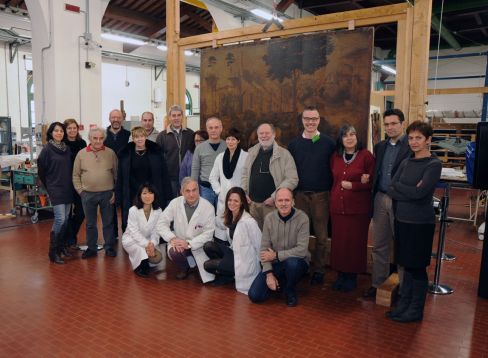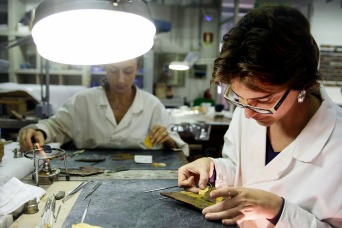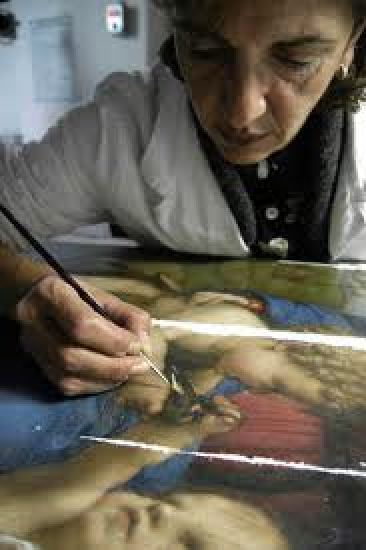 One of the most touching masterpieces of the Renaissance will be welcomed back to Florence’s Uffizi Gallery, after a restoration lasting 10 years. The Madonna of the Goldfinch, painted by Raphael in 1506, shows Mary with John the Baptist and Jesus as children at her feet, and John offering Jesus a goldfinch which the latter strokes. The goldfinch symbolises Christ’s crucifixion because it is a bird that feeds among thorns. One legend has it that a goldfinch plucked out a thorn that was digging painfully into Christ’s brow as he was on his way to be crucified.The painting, 42in by 30in, was executed when Raphael was 23. It was a wedding gift for Lorenzo Nasi, a wool merchant from Florence. The painting’s problems began in 1547 when Nasi’s house collapsed, smashing the picture into 17 pieces. It was put together using nails and painted over by a contemporary of Raphael, Ridolfo di Ghirlandaio, to hide the joins.
One of the most touching masterpieces of the Renaissance will be welcomed back to Florence’s Uffizi Gallery, after a restoration lasting 10 years. The Madonna of the Goldfinch, painted by Raphael in 1506, shows Mary with John the Baptist and Jesus as children at her feet, and John offering Jesus a goldfinch which the latter strokes. The goldfinch symbolises Christ’s crucifixion because it is a bird that feeds among thorns. One legend has it that a goldfinch plucked out a thorn that was digging painfully into Christ’s brow as he was on his way to be crucified.The painting, 42in by 30in, was executed when Raphael was 23. It was a wedding gift for Lorenzo Nasi, a wool merchant from Florence. The painting’s problems began in 1547 when Nasi’s house collapsed, smashing the picture into 17 pieces. It was put together using nails and painted over by a contemporary of Raphael, Ridolfo di Ghirlandaio, to hide the joins. It found its way into the possession of the Medicis, the ruling family of Florence during the Renaissance, and the original radiant beauty of the painting was further obscured by successive attempts to cover up the damage. So when Opificio delle Pietre Dure, one of Italy’s state-run picture restoration laboratories, was approached about the possibility of restoring the picture to its original splendour, it approached it with great diffidence. “This patient gave us the most shivers and the
It found its way into the possession of the Medicis, the ruling family of Florence during the Renaissance, and the original radiant beauty of the painting was further obscured by successive attempts to cover up the damage. So when Opificio delle Pietre Dure, one of Italy’s state-run picture restoration laboratories, was approached about the possibility of restoring the picture to its original splendour, it approached it with great diffidence. “This patient gave us the most shivers and the
 most sleepless nights,” Marco Ciatti, head of the paintings department of the lab, told Reuters. “We spent two whole years studying it before deciding whether to go ahead, because with the damage it had suffered in the past – which was clearly visible in the X-rays – a restoration attempt could go wrong.”
most sleepless nights,” Marco Ciatti, head of the paintings department of the lab, told Reuters. “We spent two whole years studying it before deciding whether to go ahead, because with the damage it had suffered in the past – which was clearly visible in the X-rays – a restoration attempt could go wrong.”
 In the end they decided to proceed, and the restorer who pulled the short straw was Patrizia Riitano. The painting has been her life for years. “I am just a technician but I probably know this painting almost better than Raphael,” she said. “He looked at it of course, but all these years I have been looking at it through a microscope.” She headed a team of 50 including wood specialists and photography technicians. The restoration team decided that the larger nails holding the picture together should stay, as removing them risked doing more harm. The grime obscuring the picture’s beautifully balanced golds, reds and blues has been meticulously stripped away. Now, Madonna del cardellino, as it is known in Italian, is the centrepiece of a show on the restoration at Florence’s Palazzo Medici, before returning to the Uffizi. Antonio Natali, of the Uffizi, said: “We will celebrate it like the return of our prodigal daughter.”
In the end they decided to proceed, and the restorer who pulled the short straw was Patrizia Riitano. The painting has been her life for years. “I am just a technician but I probably know this painting almost better than Raphael,” she said. “He looked at it of course, but all these years I have been looking at it through a microscope.” She headed a team of 50 including wood specialists and photography technicians. The restoration team decided that the larger nails holding the picture together should stay, as removing them risked doing more harm. The grime obscuring the picture’s beautifully balanced golds, reds and blues has been meticulously stripped away. Now, Madonna del cardellino, as it is known in Italian, is the centrepiece of a show on the restoration at Florence’s Palazzo Medici, before returning to the Uffizi. Antonio Natali, of the Uffizi, said: “We will celebrate it like the return of our prodigal daughter.”


















